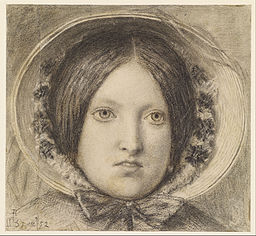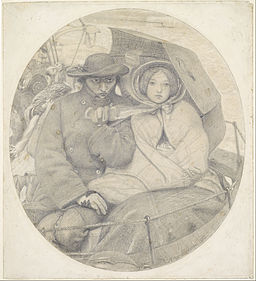
“The Last of England” by Ford Madox Brown depicts two emigrants leaving England to start a new life in Australia with their small baby.
The emigrating couple stares stoically ahead, stony-faced, ignoring Dover’s white cliffs, which can be seen disappearing behind them in the top right of the picture.
They are huddled under an umbrella that provides shelter from the sea-spray. The faces of the man and his wife, who are seeing England for the last time, are modeled on the artist, Brown, and his second wife, Emma’s portraits.
In the foreground, a row of cabbages hangs from the ship’s rail, provisions for the long voyage. In the background are other passengers, including a pair of drunken men, one of whom was conceived by Brown as shaking his fist and cursing the land of his birth.
Also, in the background is a family consisting of the father, eldest daughter, and younger children, their mother (like Brown’s first wife) has died, and they are seeking a new beginning.

Portrait of Emma Hill by Ford Madox Brown
The father is barely visible except for the pipe he holds, and his daughter has her arm around a curly red-haired boy. The fair-haired child eating an apple is a portrait of the artist’s first daughter, Catherine.
The woman has a baby concealed under the cloak in the foreground, whose hand she is clasping; this baby symbolized the artist’s second infant child.
The family’s clothing and the bundle of books next to them indicate that they are middle class and educated. Brown composed a short verse to accompany the painting in which the woman is depicted as hopeful for the future:
“She grips his listless hand and clasps her child,
Through rainbow tears, she sees a sunnier gleam,
She cannot see a void where he will be.”
Brown began the painting in 1852, inspired by the departure of his close friend, the Pre-Raphaelite sculptor, Thomas Woolner, who had left for Australia that year. Emigration from England was at over 350,000 people that year.
At the time of this painting, Brown was thinking of moving to India with his new family. This painting may explain his feelings about leaving and why he did not emigrate?
Although Ford Madox Brown was never a member of the Pre-Raphaelite Brotherhood, this painting, like many of his paintings, exhibits the movement’s characteristics in its bright color and a particular focus on naturalistic detail.
The format of the picture is circular. It may have been influenced by telescopes at the seaside, which became the fashion at mid-century.
This painting was voted Britain’s eighth-favorite picture in a poll carried out by BBC Radio. It was also voted 32 out of 57 paintings chosen by the British public from national collections used in a large Art Exhibition.

The Last of England – Cartoon, Pencil, image edged with brown ink on paper.
Ford Madox Brown
Ford Madox Brown (1821 – 1893) was a French-born British painter of moral and historical subjects, notable for his distinctively graphic Pre-Raphaelite style.
Brown spent the latter years painting the twelve works known as The Manchester Murals, depicting Mancunian history, for Manchester Town Hall.
Ford Madox Brown was married twice. His first wife died in Paris, aged 27, on the journey back to England from Rome.
Emma Hill became a frequent Brown model, six years after his first wife’s death; she is the wife in “The Last of England.”
Emma became his mistress, and they shared a house in London, but social convention made him unable to marry an illiterate daughter of a bricklayer. After the birth of his first daughter, they were married.
The Last of England
- Title: The Last of England
- Artist: Ford Madox Brown
- Date: 1855
- Medium: Oil on canvas
- Style: Pre-Raphaelite
- Dimensions: W: 750 x H: 825 mm
- Museum: Birmingham Museum and Art Gallery
Ford Madox Brown
- Name: Ford Madox Brown
- Born: 1821, Calais, Kingdom of France
- Died: 1893 (aged 72), London, England
- Nationality: English
- Notable works:
- The Last of England
- Romeo and Juliet
“The Last of England” by Ford Madox Brown
Pre-Raphaelites
The Pre-Raphaelites focused on painting subjects from modern life, and literature often used historical costumes for accuracy. They painted directly from nature itself, as accurately as possible, and with intense attention to detail.
The Pre-Raphaelites defined themselves as a reform movement, created a distinct name for their art, and published a periodical to promote their ideas.
The Pre-Raphaelites was a group of English painters, poets, and art critics, founded in 1848.
The group intended to reform art by rejecting what it considered the mechanistic approach first adopted by the artists who succeeded Raphael and Michelangelo, hence the name “Pre-Raphaelite.”
The Pre-Raphaelite Brotherhood sought a return to the abundant detail, intense colors, and complex compositions of Pre-Raphaelite Italian art.
Ford Madox Brown
Exploring Pre-Raphaelite Art
John Everett Millais
- Isabella
- Christ in the House of His Parents
- The Martyr of Solway
- Ophelia
- Blow Blow Thou Wind
- The Black Brunswicker
- A Dream of the Past: Sir Isumbras at the Ford
- The North-West Passage
William Holman Hunt
- The Finding of the Savior in the Temple
- Our English Coasts
- Isabella and the Pot of Basil
- Self-portrait William Holman Hunt
- Sheltering a Christian Missionary from the Persecution of the Druids
- The Scapegoat
- The Lady of Shalott
Dante Gabriel Rossetti
- Lady Lilith
- Dante’s Dream
- Dante Gabriel Rossetti – Self Portrait
- The Beloved
- Bocca Baciata
- Paolo and Francesca da Rimini
- The Day Dream
- The First Anniversary of the Death of Beatrice
- Helen of Troy
John William Waterhouse
- The Lady of Shalott
- The Favorites of the Emperor Honorius
- Circe Invidiosa
- Diogenes
- I Am Half-Sick of Shadows, Said the Lady of Shalott
- Hylas and the Nymphs
- Echo and Narcissus
- Ulysses and the Sirens
- Consulting the Oracle
- A Tale from the Decameron
- Circe Offering the Cup to Ulysses
- Saint Eulalia
- Fair Rosamund
- Lamia
Marie Spartali Stillman
- Love’s Messenger
Ford Madox Brown
- Romeo and Juliet
- The Last of England
Henry Holiday
- Dante and Beatrice
Edward Burne-Jones
- The Star of Bethlehem
- King Cophetua and the Beggar Maid
Frederick Sandys
- Queen Eleanor
- Morgan-le-Fay
- Mary Magdalene
- Medea
Frank Dicksee
- The Funeral of a Viking
John Collier
- Lady Godiva
- The Last Voyage of Henry Hudson
William Dyce
- Francesca da Rimini
Arthur Hughes
- Fair Rosamund
- The Eve of St Agnes
Pre-Raphaelite Art Objects
- The Great Bookcase
A Virtual Tour of Museums in the United Kingdom
- London Museum
- Edinburgh Museums
- Glasgow Museums
- Liverpool Museums
- Manchester Museums
- Bath Museums
- Birmingham Museums
Ford Madox Brown and Pre-Raphaelites at Manchester Art Gallery
Quotes about the Pre-Raphaelite Movement
~~~
“All great art is the work of the whole living creature, body and soul, and chiefly of the soul.”
– John Ruskin
~~~
“The greatest foe to art is luxury; art cannot live in its atmosphere.”
– William Morris
~~~
“Art is not a study of positive reality; it is the seeking for ideal truth.”
– John Ruskin
~~~
“Better by far, you should forget and smile than that you should remember and be sad.”
– Christina Rossetti
~~~
“The past is not dead; it is living in us and will be alive in the future, which we are now helping to make.”
– William Morris
~~~
“The artist has done nothing till he has concealed himself — the art is imperfect which is visible-the feelings are but feebly touched if they permit us to reason on the methods of their excitement.”
– John Ruskin
~~~
“With the arrogance of youth, I determined to do no less than to transform the world with Beauty. If I have succeeded in some small way, if only in one small corner of the world, amongst the men and women I love, then I shall count myself blessed, and blessed, and blessed, and the work goes on.”
– William Morris
~~~
“When I am dead, my dearest,
Sing no sad songs for me.”
– Christina Rossetti
~~~
“Love, which is quickly kindled in the gentle heart, seized this man for the fair form that was taken from me; the manner still hurts me. Love which absolves no beloved one from loving, seized me so strongly with his charm that, as thou sees, it does not leave me yet.”
– Dante Gabriel Rossetti
~~~
“When love and skill work together, expect a masterpiece.”
– John Ruskin
~~~
Photo Credit: Ford Madox Brown [Public domain]
Popular this Week








 Sponsor your Favorite Page
Sponsor your Favorite Page SEARCH Search for: Search Follow UsJoin – The JOM Membership Program
Sponsor a Masterpiece with YOUR NAME CHOICE for $5
Share this:
- Tweet
